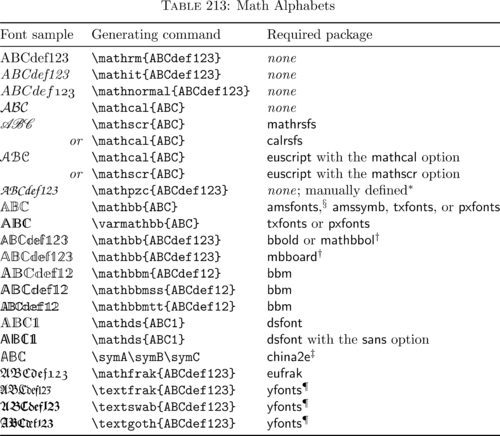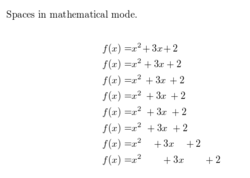Latex
Appearance
Installation
No Install
Use Overleaf to create latex documents in a web browser.
Partial Install
Download MikTex. It includes the TeXworks editor and will download packages as you use them. This will not take up as much disk space as a full install.
Full Install
Windows
Download TexLive. This is several gigabytes since it includes all the popular LaTex packages and takes a while to install. You'll also need an editor. I recommend installing Atom with the following packages:
latexfor calling the TexLive compilerlanguage-latexfor syntax highlightingpdf-viewfor viewing the compiled pdf.
Linux
sudo apt install texlive-full
Compile tex documents with
pdflatex [mydocument.tex]
Usage
Fancy Math Font

See this answer.
% Use mathbb for the set of reals R or the set of complex numbers C
% Requires amsfonts
\mathbb{R}
Spaces
See Reference

Spaces in mathematical mode.
\begin{align*}
f(x) =& x^2\! +3x\! +2 \\
f(x) =& x^2+3x+2 \\
f(x) =& x^2\, +3x\, +2 \\
f(x) =& x^2\: +3x\: +2 \\
f(x) =& x^2\; +3x\; +2 \\
f(x) =& x^2\ +3x\ +2 \\
f(x) =& x^2\quad +3x\quad +2 \\
f(x) =& x^2\qquad +3x\qquad +2
\end{align*}
Indents
Section
\hspace*{5mm}\begin{minipage}{\dimexpr\textwidth-5mm}
Indented Section
\end{minipage}
Programming
Latex is a turing complete language.
You can use if statements and for loops in latex.
Useful Commands
A list of potentially useful commands
\newcommand{\degree}{\ensuremath{^{\circ}} }
\newcommand{\etal}{{\em et al. }}
Tikz
Tikz is used to draw graphs and other shapes
Drawing over images
\begin{tikzpicture}
\node[anchor=south west,inner sep=0] (image) at (0,0) {
\includegraphics[width=.9\linewidth]{my_image.png}
};<br />
\begin{scope}[x={(image.south east)},y={(image.north west)}]
\draw[black,ultra thick,rounded corners] (0.0,0.1) rectangle (0.3,0.5);
\draw[red,ultra thick,rounded corners] (0.5,0.1) rectangle (0.8,0.5);
% \draw[help lines,xstep=.1,ystep=.1] (0,0) grid (1,1);
% \foreach \x in {0,1,...,9} { \node [anchor=north] at (\x/10,0) {0.\x}; }
% \foreach \y in {0,1,...,9} { \node [anchor=east] at (0,\y/10) {0.\y}; }
\end{scope}
\end{tikzpicture}
